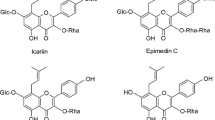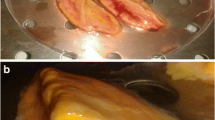Summary
Conotoxin GIIIA and GIIIB from the marine snail Conus geographus have been reported to inhibit voltage-dependent Na channels in skeletal muscle and postganglionic sympathetic neuron, but have no effect on Na channels in brain, giant axon and heart. In eel electroplax, conotoxins were also shown to share the common binding sites with saxitoxin (see review Gray et al. 1988).
In bovine adrenal medullary cells, conotoxin GIIIA inhibited veratridine-induced influx of 22Na, 45Ca and secretion of catecholamines with an IC50 of 6 μmol/l, while saxitoxin suppressed veratridine-induced responses with an IC50 of 6.3 nmol/l. [3H]Saxitoxin binding to the cells was inhibited by unlabeled saxitoxin with an IC50 of 5.1 nmol/l, but was slightly reduced by 10 μmol/l conotoxin GIIIA. Conotoxin GIIIA, at 10 μmol/l, did not alter carbachol-induced influx of 22Na, 45Ca and secretion of catecholamines as well as high K-induced 45Ca influx and catecholamine secretion.
These results indicate that conotoxin GIIIA, at concentrations 950 fold higher than saxitoxin, inhibits Na influx via voltage-dependent Na channels, but has no effect on the nicotinic receptor-ion channel complex or the voltage-dependent Ca channels. Conotoxin GIIIA seems to bind at the sites which are distinct from saxitoxin, but are functionally linked to the voltage-dependent Na channels. Conotoxins may be useful for the classification of Na channels in excitable cell membranes.
Similar content being viewed by others
References
Auld VJ, Goldin AL, Krafte DS, Marshall J, Dunn JM, Catterall WA, Lester HA, Davidson N, Dunn RJ (1988) A rat brain Na+ channel a subunit with novel gating properties. Neuron 1:449–461
Barchi RL (1987) Sodium channel diversity: subtle variations on a complex theme. TINS 10:221–223
Catterall WA, Schmidt JW, Messner DJ, Feller DJ (1986) Structure and biosynthesis of neuronal sodium channels. Anna NY Acad Sci 479:186–203
Cruz LJ, Gray WR, Olivera BM, Zeikus RD, Kerr L, Yoshikami D, Moczydlowski E (1985) Conus geographus toxins that discriminate between neuronal and muscle sodium channels. J Biol Chem 260:9280–9288
Gonoi T, Ohizumi Y, Nakamura H, Kobayashi J, Catterall WA (1987) The conus toxin Geographutoxin II distinguishes two functional sodium channel subtypes in rat muscle cells developing in vitro. J Neurosci 7:1728–1731
Gordon D, Merrick D, Auld V, Dunn R, Goldin AL, Davidson N, Catterall WA (1987) Tissue-specific expression of the RI and RII sodium channel subtypes. Proc Natl Acad Sci USA 84:8682–8686
Gray WR, Olivera BM, Cruz LJ (1988) Peptide toxins from venomous conus snails. Ann Rev Biochem 57:665–700
Isenberg KE, Meyer GE (1989) Cloning of a putative neuronal nicotinic acetylcholine receptor subunit. J Neurochem 52: 988–991
Kayano T, Noda M, Flockerzi V, Takahashi H, Numa S (1988) Primary structure of rat brain sodium channel III deduced from the cDNA sequence. FEBS Lett 228:187–194
Kobayashi M, Wu CH, Yoshii M, Narahashi T, Nakamura H, Kobayashi J, Ohizumi Y (1986) Preferential block of skeletal muscle sodium channels by geographutoxin 11, a new peptide toxin from Conus geographus. Pflügers Arch 407:241–243
Miller RJ (1987) Multiple calcium channels and neuronal function. Science 235:46–52
Moczydlowski E, Olivera BM, Gray WR, Strichartz GR (1986a) Discrimination of muscle and neuronal Na-channel subtypes by binding competition between [3H]saxitoxin and μ-conotoxins. Proc Natl Acad Sci USA 83:5321–5325
Moczydlowski E, Uehara A, Guo X, Heiny J (1986b) Isochannels and blocking modes of voltage-dependent sodium channels. Anna NY Acad Sci 479:269–292
Nakamura H, Kobayashi J, Ohizumi Y, Hirata Y (1983) Isolation and amino acid composition of geographutoxin I and II from the marine snail Conus geographus Linné. Experientia 39: 590–591
Noda M, Shimizu S, Tanabe T, Takai T, Kayano T, Ikeda T, Takahashi H, Nakayama H, Kanaoka Y, Minamino N, Kangawa K, Matsuo H, Raftery MA, Hirose T, Inayama S, Hayashida H, Miyata T, Numa S (1984) Primary structure of Electrophorus electricus sodium channel deduced from cDNA sequence. Nature 312:121–127
Noda M, Ikeda T, Kayano T, Suzuki H, Takeshima H, Kurasaki M,Takahashi H, Numa S (1986) Existence of distinct sodium channel messenger RNAs in rat brain. Nature 320:188–192
Ohizumi Y, Nakamura H, Kobayashi J (1986a) Presynaptic inhibitory effect of geographutoxin 11, a new peptide toxin from Conus geographus venom, in the guinea-pig vas deferens. Eur J Pharmacol 120:245–248
Ohizumi Y, Minoshima S, Takahashi M, Kajiwara A, Nakamura H, Kobayashi J (1986b) Geographutoxin 11, a novel peptide inhibitor of Na channels of skeletal muscles and autonomic nerves. J Pharmacol Exp Ther 239:243–248
Ohizumi Y, Nakamura H, Kobayashi J, Catterall WA (1986c) Specific inhibition of [3H]saxitoxin binding to skeletal muscle sodium channels by geographutoxin 11, a polypeptide channel blocker. J Biol Chem 261:6149–6152
Rogart RB (1986) High-STX-affinity vs. low-STX-affinity Na+ channel subtypes in nerve, heart, and skeletal muscle. Anna NY Acad Sci 479:402–430
Rogart RB, Cribbs LL, Muglia LK, Kephart DD, Kaiser MW (1989) Molecular cloning of a putative tetrodotoxin-resistant rat heart Na+ channel isoform. Proc Natl Acad Sci 86:8170–8174
Spence I, Gillessen D, Gregson RP, Quinn RJ (1977) Characterization of the neurotoxin constituents of Conus geographus (L) venom. Life Sci 21:1759–1770
Suzuki H, Beckh S, Kubo H, Yahagi N, Ishida H, Kayano T, Noda M, Numa S (1988) Functional expression of cloned cDNA encoding sodium channel III. FEBS Lett 228:195–200
Trimmer JS, Cooperman SS, Tomiko SA, Zhou J, Crean SM, Boyle MB, Kallen RG, Sheng Z, Barchi RL, Sigworth FS,Goodman RH, Agnew WS, Mandel G (1989) Primary structure and functional expression of a mammalian skeletal muscle sodium channel. Neuron 3:33–49
Trimmer JS, Agnew WS (1989) Molecular diversity of voltagesensitive Na channels. Ann Rev Physiol 51:401–418
Wada A, Izumi F, Yanagihara N, Kobayashi H (1985ady) Modulation by ouabain and diphenylhydantoin of veratridine-induced 22Na influx and its relation to 45Ca influx and the secretion of catecholamines in cultured bovine adrenal medullary cells. Naunyn-Schmiedeberg's Arch Pharmacol 328:273–278
Wada A, Takara H, Izumi F, Kobayashi H, Yanagihara N (1985b) Influx of 22Na through acetylcholine receptor-associated Na channels: relationship between 22Na influx, 45Ca influx and secretion of catecholamines in cultured bovine adrenal medullary cells. Neuroscience 15:283–292
Wada A, Takara H, Yanagihara N, Kobayashi H, Izumi F (1986) Inhibition of Na+ -pump enhances carbachol-induced influx of 45Ca2+ and secretion of catecholamines by elevation of cellular accumulation of 12 Na+ in cultured bovine adrenal medullary cells. Naunyn-Schmiedeberg's Arch Pharmacol 332:351–356
Wada A, Arita M, Kobayashi H, Izumi F (1987) Binding of [3H]saxitoxin to the voltage-dependent Na channels and inhibition of 22Na influx in bovine adrenal medullary cells. Neuroscience 23:327–331
Wada K, Ballivet M, Boulter J, Connolly J, Wada E, Deneris ES, Swanson LW, Heinemann S, Patrick J (1988) Functional expression of a new pharmacological subtype of brain nicotinic acetylcholine receptor. Science 240:330–334
Weil-Malherbe H (1952) The chemical estimation of adrenaline like substances in blood. Biochem J 51:311–318
Worley JF, French RJ, Krueger BK (1986) Trimethyloxonium modification of single batrachotoxin-activated sodium channels in planar bilayers. J Gen Physiol 87:327–349
Yanagawa Y, Abe T, Satake M (1986) Blockade of [3H]lysine-tetrodotoxin binding to sodium channel proteins by conotoxin GIII. Neurosci Lett 64:7–12
Yanagawa Y, Abe T, Satake M (1987) μ-Conotoxins share a common binding site with tetrodotoxin/saxitoxin on eel electroplax Na channels. J Neurosci 7:1498–1502
Author information
Authors and Affiliations
Additional information
Send offprint requests to A. Wada at the above address
Rights and permissions
About this article
Cite this article
Wada, A., Uezono, Y., Arita, M. et al. Conotoxin GIIIA: selective inhibition of 22Na influx via voltage-dependent Na channels in adrenal medullary cells. Naunyn-Schmiedeberg's Arch Pharmacol 342, 323–327 (1990). https://doi.org/10.1007/BF00169444
Received:
Accepted:
Issue Date:
DOI: https://doi.org/10.1007/BF00169444




